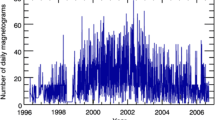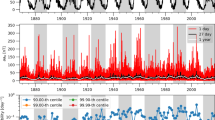Abstract
In late October and early November 2003, a series of space weather hazard events erupted in solar-terrestrial space. Aiming at two intense storm (shock) events on 28 and 29 October, this paper presents a Two-Step method, which combines synoptic analysis of space weather–`observing’ and quantitative prediction – ‘palpating’, and uses it to test predictions. In the first step, ‘observing’, on the basis of observations of the source surface magnetic field, interplanetary scintillation (IPS) and ACE spacecraft, we find that the propagation of the shock waves is asymmetric and northward relative to the normal direction of their solar sources due to the large-scale configuration of the coronal magnetic fields, and the Earth is located near the direction of the fastest speed and greatest energy of the shocks. Being two fast ejection shock events, the fast explosion of extremely high temperature and strong magnetic field, and background solar wind velocity as high as 600 and 1000 km s−1, are also helpful to their rapid propagation. According to the synoptic analysis, the shock travel times can be estimated as 21 and 20 h, which are close to the observational results of 19.97 and 19.63 h, respectively. In the second step, ‘palpating’, we adopt a new membership function of the fast shock events for the ISF method. The predicted results here show that for the onset time of the geomagnetic disturbance, the relative errors between the observational and the predicted results are 1.8 and 6.7%, which are consistent with the estimated results of the first step; and for the magnetic disturbance magnitude, the relative errors between the observational and the predicted results are 4.1 and 3.1%, respectively. Furthermore, the comparison among the predicted results of our Two-Step method with those of five other prevailing methods shows that the Two-Step method is advantageous in predicting such strong shock event. It can predict not only shock arrival time, but also the magnitude of magnetic disturbance. The results of the present paper tell us that understanding the physical features of shock propagation thoroughly is of great importance in improving the prediction efficiency.
Similar content being viewed by others
References
Barbieri, L.P. and Mahmot, R.E.: 2004, Space Weather 2, S09002.
Cary, O.: 2004, Space Weather 2, S08001.
Cho, K.-S., Moon, Y.-J., Dryer, M., Fry, C.D., Park, Y.-D., and Kim, K.-S.: 2003, J. Geophys. Res. 108, 1445.
Dryer, M. and Smart, D.F.: 1984, Adv. Space Res. 4, 291.
Dryer, M., Smith, Z., Fry, C.D., Sun, W., Deehr, C.S., and Akasofu, S.-I.: 2004, Space Weather 2, S09001.
Fry, C.D., Sun, W., Deehr, C.S., Dryer, M., Smith, Z., Akasofu, S.-I., Tokumaru, M., and Kojima, M.: 2001, J. Geophys. Res. 106(20), 985.
Fry, C.D., Dryer, M., Deehr, C.S., Sun, W., Akasofu, S.-I., and Smith, Z.: 2003, J. Geophys. Res. 108, 1070.
Gopalswamy, N., Barbieri, L., Lu, G., Plunkett, S.P., and Skoug, R.M.: 2005, Geophys. Res. Lett. 32, L03S01.
Hakamada, K. and Akasofu S.-I.: 1982, Space Sci. Rev. 31, 3.
Kojima, M. and Kakinuma, T.J.: 1987, J. Geophys. Res. 92, 7269.
Kuwabara, T., Munakata, K., Yasue, S., Kato, C., Akahane, S., Koyama, M., Bieber, J.W., Evenson, P., Pyle, R., Fujii, Z., Tokumaru, M., Kojima, M., Marubashi, K., Duldig, M.L., Humble, J.E., Silva, M. R., Trivedi, N.B., Gonzalez, W.D., and Schuch, N.J.: 2004, Geophys. Res. Lett. 31, L19803.
Lario, D., Decker, R.B., Livi, S., Krimigis, S.M., Roelof, E.C., Russell, C. T., and Fry, C.D.: 2005, J. Geophys. Res. 110, A09S11.
Lopez, R.E., Baker, D.N. and Allen, J.E.: 2004, Eos Trans. AGU. 85, 105.
Malandraki, O.E., Lario, D., Lanzerotti, L.J., Sarris, E.T., Geranios, A., and Tsiropoula, G.: 2005, J. Geophys. Res. 110, A09S06.
Manoharan, P.K., Gopalswamy, N., Yashiro, S., Lara, A., Michalek, G., and Howard, R.A.: 2004, J. Geophys. Res. 109, A06109.
Moon, Y.-J., Dryer, M., Smith, Z., Park, Y.D., and Cho K.-S.: 2002, Geophys. Res. Lett. 29, 1390.
Pinter, S.: 1982, Space Sci. Rev. 32, 145.
Rickett, B.T. and Kakinuma, T.J.: 1991, J. Geophys. Res. 96, 1717.
Skoug, R.M., Gosling, J.T., Steinberg, J.T., McComas, D.J., Smith, C.W., Ness, N.F., Hu, Q., and Burlaga, L.F.: 2004, J. Geophys. Res. 109, A09102.
Smith, Z., Dryer, M., Ort, E., and Murtagh, W.: 2000, J. Atmos. Sol. Terr. Phys. 62, 1265.
Watanabe, T. and Schwenn, R.: 1989, Space Sci. Rev. 51, 147.
Webb, D. and Allen, J.: 2004, Space Weather. 2, S03008.
Wei, F.S.: 1982, Chinese Journal of Space Science. 6, 76.
Wei, F.S.: 1984, Acta Geophysica Sinica 27, 417.
Wei, F.S. and Cai, H.C.: 1990, Chinese Journal of Space Science 10, 35.
Wei, F.S. and Dryer, M.: 1991, Solar Phys. 132, 373.
Wei, F.S., Cai, H.C., Feng, X.S., and Shi, J.K.: 2003, Adv. Space Res. 31, 1069.
Wei, F.S., Feng, X.S., Xu, Y., and Fan, Q.L.: 2005, Adv. Space Res. 36, 2363.
Woods, T.N., Eparvier, F.G., Fontenla, J., Harder, J., Kopp, G., McClintock, W.E., Rottman, G., Smiley, B., and Snow, M.: 2004, Geophys. Res. Lett. 31, L10802.
Zurbuchen, T.H., Gloeckler, G., Ipavich, F., Raines, J., Smith, C.W., and Fisk, L.A.: 2004, Geophys. Res. Lett. 31, L11805.
Author information
Authors and Affiliations
Corresponding author
Rights and permissions
About this article
Cite this article
Xie, Y., Wei, F., Feng, X. et al. Prediction Test for the Two Extremely Strong Solar Storms in October 2003. Sol Phys 234, 363–377 (2006). https://doi.org/10.1007/s11207-006-0091-8
Received:
Accepted:
Issue Date:
DOI: https://doi.org/10.1007/s11207-006-0091-8




